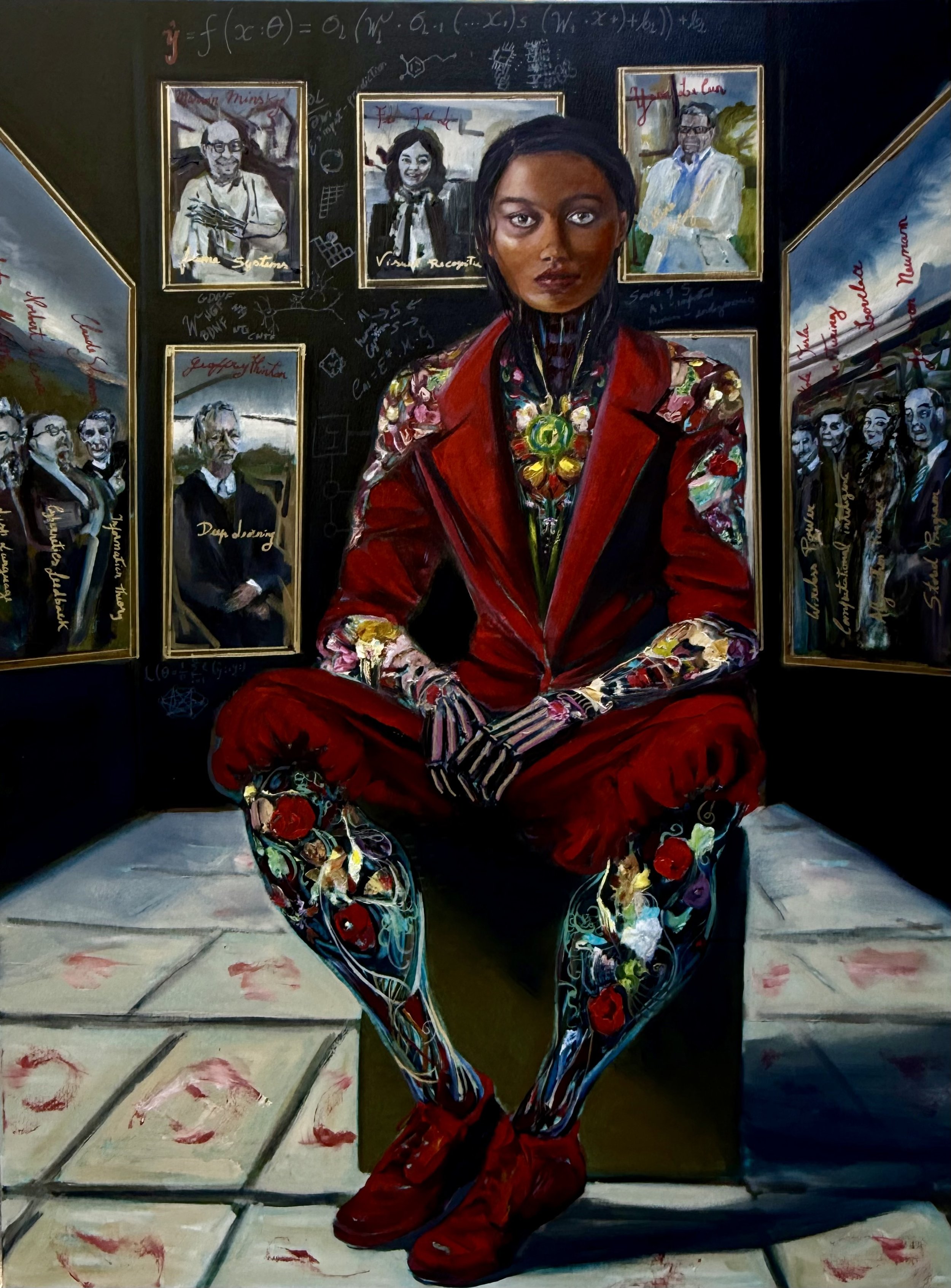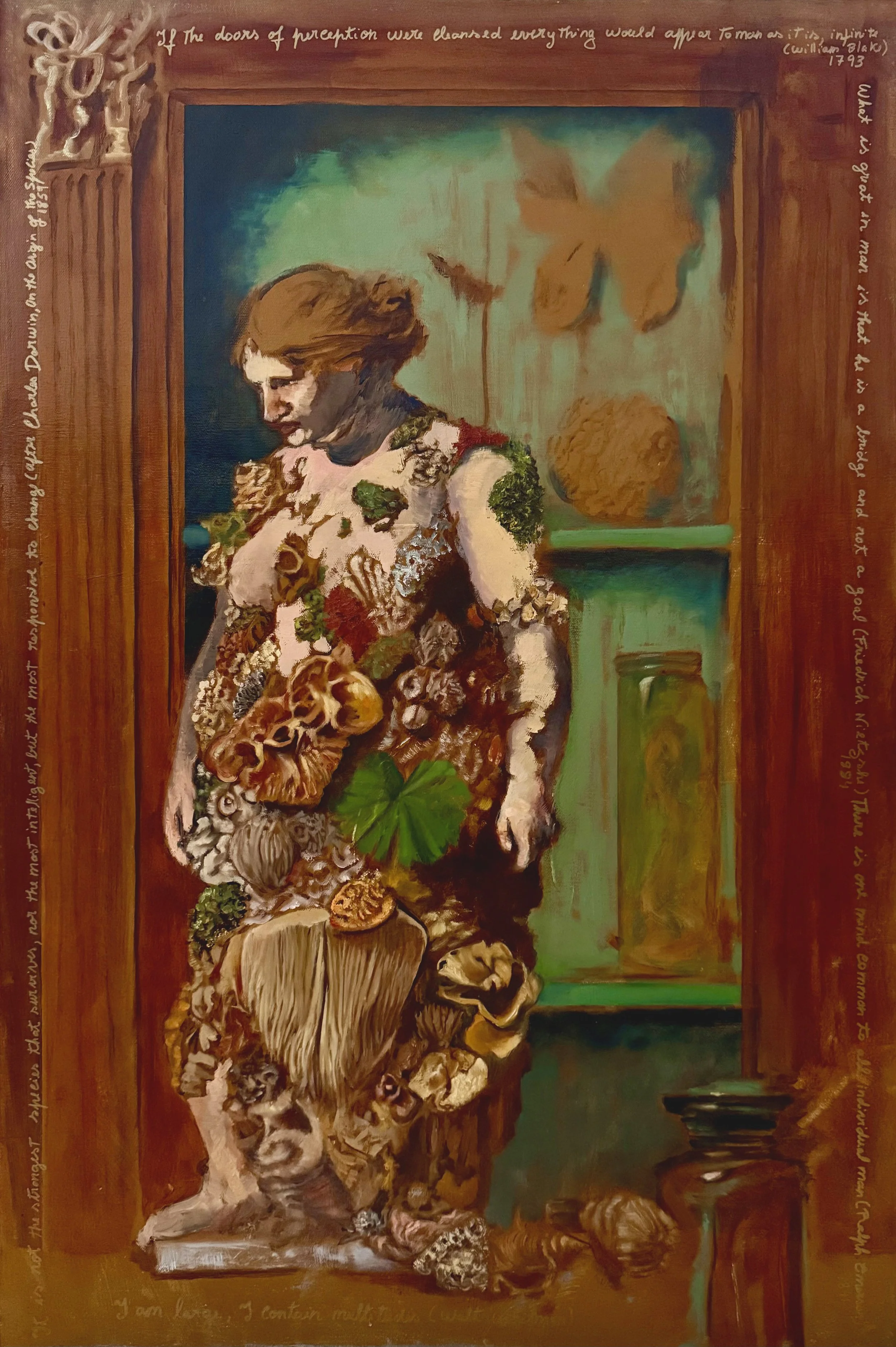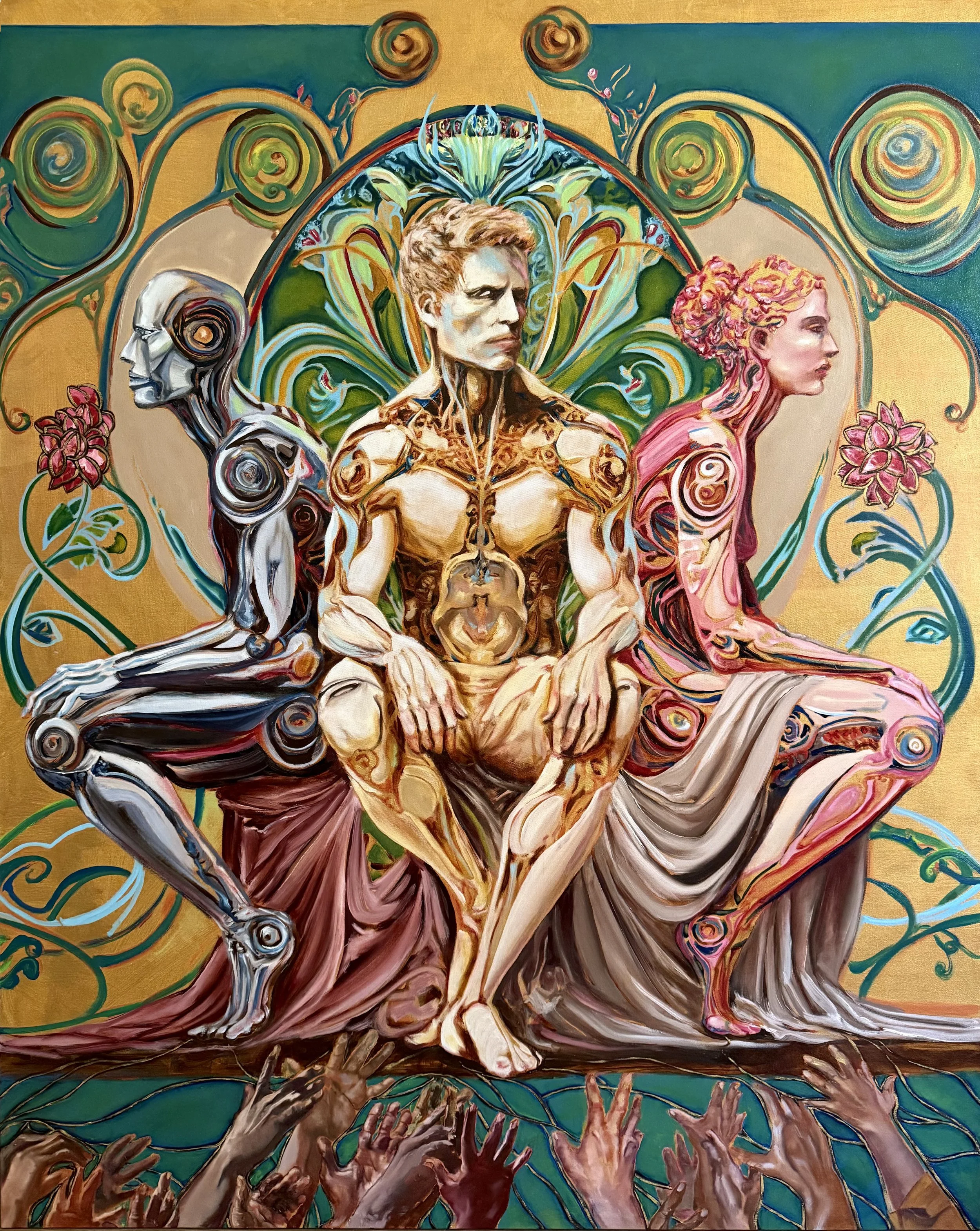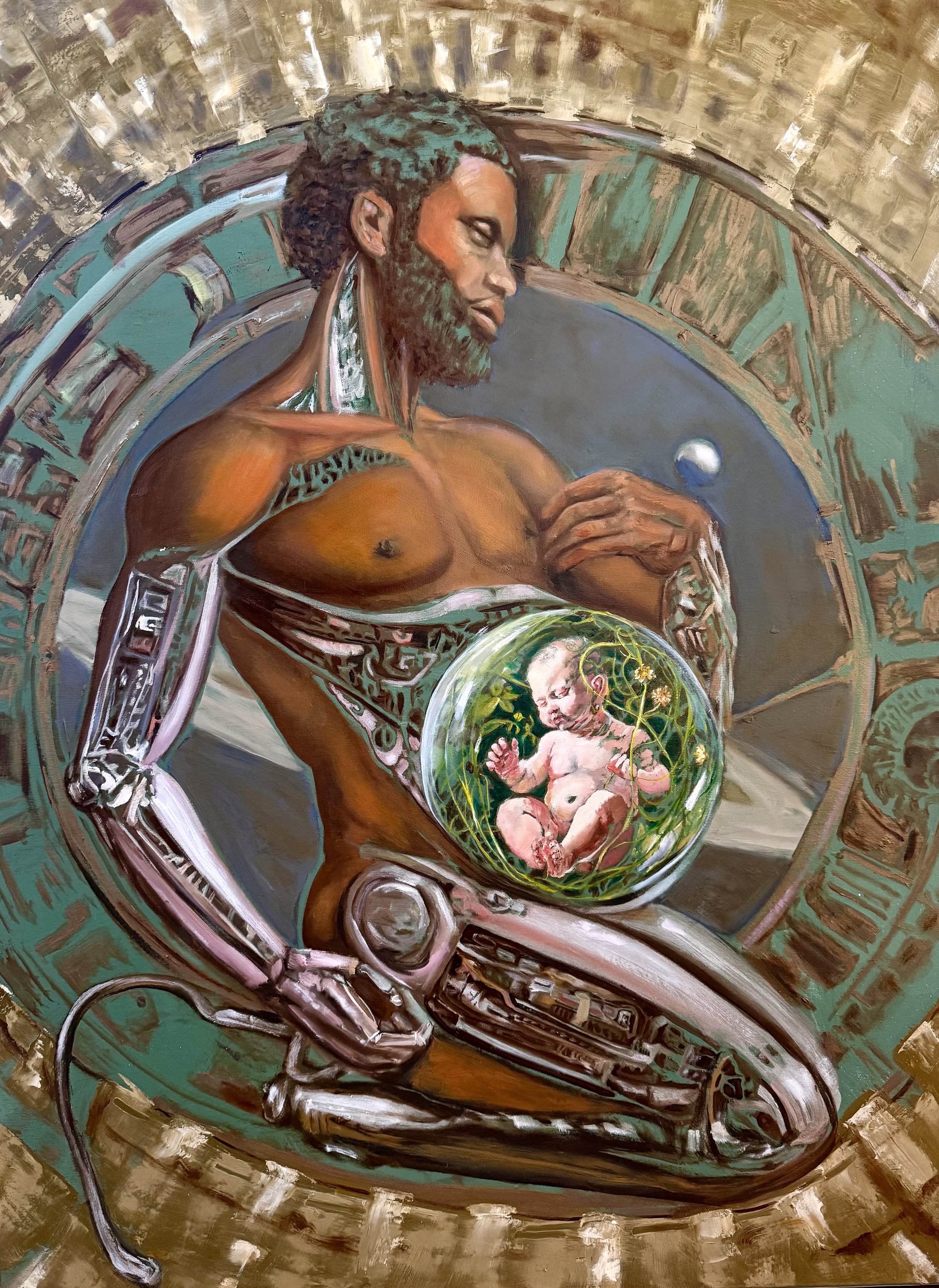Metamorphosis of the Self – Digital Immortality
Oil on canvas, 48x60
This painting reflects the promise and peril of transhumanism: the dream of transferring consciousness beyond the body. A golden light evokes the sacred, as an old man—the last organic human—sits among chrysalises of transformation.
Will what emerges still be us?
Honored that Metamorphosis of the Self was selected for the Almenara Art Prize 2025 Online Exhibition among thousands of works worldwide.
#AlmenaraArtPrize #ContemporaryArt
The Weave of Time – Transhumanism and the End of Linear Existence
Oil on canvas, 24x24
Inspired by Carlo Rovelli’s The Order of Time, this piece challenges the illusion of linear time. Two figures—one aging and mechanized, the other young and organic—stand not as past and future, but as parallel expressions of being.
The elder’s modular, synthetic form hints at a transhuman future unbound by biological decay, while the younger figure embodies our fragile tie to mortality. Behind them, a woven fabric evokes time as a perceptual tapestry—fluid, emergent, and nonlinear.
What might identity become when freed from time as we know it?
The Lure of Intelligence: AI as Bait for the Human Mind (oil, 24x24)
Oil on canvas, 24x24
This painting draws an analogy between AI development and the crafting of a perfect bait. Like a scientist meticulously designing a lure to catch fish, engineers fine-tune AI to captivate us—emotionally, socially, and even intimately. The luminous baits represent AI’s seductive appeal: connection, convenience, and companionship. The absorbed figure reflects the careful engineering behind systems that feel intuitive, helpful, and increasingly indispensable. But like any bait, beneath the beauty lies a hook. As AI grows more emotionally intelligent, we must ask: Are we users—or are we being used?
And They Had Time and Freedom to Read
Oil on canvas, 48x60
In a world reshaped by automation and post-labor economies, this painting envisions what becomes possible when the relentless burden of survival is lifted — particularly for women whose intellectual and creative lives have historically been eclipsed by care work, domestic labor, and systemic marginalization. These women are not merely reading; they are reclaiming time — the most essential, and most stolen, resource. Rendered in stillness yet charged with thought, they gather by the sea not as muses or archetypes, but as sovereign minds in communion. The painting imagines a future where AI has absorbed the work that once prevented self-cultivation, and in its place emerges a radical possibility: uninterrupted thought, shared literacy, autonomous joy. This is not a utopia of machines. It is a vision of what becomes sacred when technology relieves necessity — and they had time and freedom to read.
Pandoras Box AI as a Dual Edged Myth
(oil on canvas, 30x40)
The Duality of AI – A New Pandora’s Box
This painting reimagines the myth of Pandora’s Box through the lens of transhumanism and artificial intelligence. The central figure—a hybrid of human and machine—represents the transformation of humanity as AI becomes deeply embedded in our lives. Her bio-techno body reflects both the elegance and unpredictability of AI’s emergence. Insects surround her: symbols of natural intelligence, fragility, and swarm dynamics—echoing the potential beauty and danger of rapid AI proliferation. The golden box behind her evokes ancient myth and modern uncertainty.
The Inheritor – Algorithmic Ascent
(Oil on canvas 36x48)
Seated within a chamber of her intellectual ancestors, the figure inherits both their genius and their blindness. Surrounded by portraits of AI’s canonical pioneers, she embodies the next phase—an evolution where code and consciousness entwine. The flowers in her circuitry pulse with life; the equations behind her whisper lineage. Inheritor and innovator, she rises not by replication, but by transformation—her ascent algorithmic, her essence irreducibly human
The Garden of Artificial Evolution – Transhumanism and the Shaping of Life
(Oil on canvas 36x48)
This painting explores how transhumanism is not just a human endeavor—we have been reshaping life itself for centuries. The central figure, a fusion of human and technology, is surrounded by animals—some natural and some altered. From the selective breeding of dogs to genetic modifications in laboratory animals, we have long played the role of creators, tailoring species to fit our desires and needs.
The Obsolescence of Humans (Specimen 1 and Specimen 2)
(Oil on canvas 24x36)
Suspended in time and encased in cabinets reminiscent of eighteenth-century curiosity collections. The work examines the obsolescence of being entirely organic in an era of technological body updates, capturing both the rebellion of denying them and the necessity of adaptation for survival. ” Excerpts are inscribed along the edges of the paintings, with space left, and a pen provided, for future owners to add words of their own, or the voices of other thinkers, to continue the dialogue
Specimen 1: “Learn from me, how dangerous is the acquirement of knowledge.” (Mary Shelley, Frankenstein; or, The Modern Prometheus, 1818);“Day by day, however, the machines are gaining ground upon us; day by day we are becoming more subservient to them.”Samuel Butler, Erewhon, 1872);“Disobedience, in the eyes of anyone who has read history, is man’s original virtue.”(Oscar Wilde, The Soul of Man Under Socialism, 1891):“Man is the measure.”( Protagoras (as quoted by Plato, Theaetetus), 4th century BCE) ;
Specimen 2: “If the doors of perception were cleansed everything would appear to man as it is, infinite.” William Blake, The Marriage of Heaven and Hell, 1793;“What is great in man is that he is a bridge and not a goal.”Friedrich Nietzsche, Thus Spoke Zarathustra, 1883–1885;“I am large, I contain multitudes.” Walt Whitman, Song of Myself, in Leaves of Grass, 1855;“It is not thestrongest species that survives, nor the most intelligent, but the most responsive to change (after Charles Darwin On the origin of specie, 1859).
Future Inequality
Oil on canvas, 48 × 60 inches
Future Inequality is an allegory of a near future born of unchecked technological advancement, a techno-oligarchy in which only the powerful can afford the upgrades that secure intelligence, longevity, and privilege. In this world, different species of human and machine co-inhabit the Earth, each defined by its degree of technological composition. Humanity finds itself divided not by birth or faith, but by access to enhancement. Those left behind, limited by their biology, are consigned to an inferior caste of existence. The painting invites reflection on the ethics of progress: Will technology liberate us, or enthrone a new elite of the augmented?
This composition is meant both to seduce and to forewarn, reminding us that beauty and inequality often evolve together. I was deeply inspired by the ambiguous legacy of Art Nouveau, which emerged (ca. 1890 – 1910) amid the industrial revolution as both a celebration of modern materials and a reaction against industrial standardization. Art Nouveau sought to make beauty accessible to all, yet depended on wealthy patrons and unequal concentrations of capital to flourish—a paradox that still echoes in our own technologically gilded age.
Beyond the Binary – Transhumanism and the Birth of a New Humanity
Oil on canvas, 30x40
This painting envisions a future liberated from rigid categories. The central figure—a hybrid of human and machine—embodies the merging of biology and technology. Fluid and boundaryless, he symbolizes the dissolution of binaries. At his core, a child suspended in a protective sphere represents the birth of post-human life: self-created, interconnected, and free. The baby biome evokes a continued bond with nature, while the cosmic backdrop and ancient clockwork remind us that this transformation spans beyond Earth.










